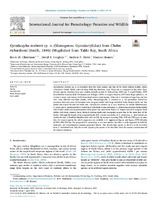| dc.description.abstract | Gyrodactylus molweni sp. n. is described from the body surface and fins of the South African mullet, Chelon
richardsonii (Smith, 1846) collected from Table Bay Harbour, Cape Town and is compared to five other Gyrodactylus species described from grey mullets globally namely G. zhukovi Ling, 1963 and G. mugili Zhukov, 1970
from Planiliza haematocheila (Temminck and Schlegel, 1845); G. mugelus Rawson, 1973 from Mugil cephalus L.; G.
curemae Conroy and Conroy, 1985 from Mugil curema Valenciennes, 1836 and G. xiamenensis Zang,Yang and Liu,
2001 from Planiliza macrolepis (Smith, 1846). Morphologically, G. molweni sp. n. has prominent ventral bar
processes that near cover the hamulus roots, marginal sickles with large rhomboid heels, slender shafts and fine
points that extend beyond the sickle toes. Gyrodactylus molweni sp. n. can, however, be readily differentiated:
G. mugili and G. xiamenensis have ventral bars with small ventral processes; G. zhukovi has marginal hooks sickles
with slender shafts and proportionately short points and open-faced blades; G. mugelus possesses marginal hook
sickles with deep, rounded heels, forward slanting shafts and an angular, square line to the inner face of the
blades. Although the length of the marginal hooks of G. curemae are similar to G. molweni sp. n., their hamuli are
double the size. A GenBank BlastN search with the 931 bp sequence covering ITS1, 5.8S and ITS2 gave no close
hits; the nearest species for which sequences are available is G. nipponensis Ogawa and Egusa, 1978 (identity
96.56%, 899/931 bp). The proposal of G. molweni sp. n. as a new species, therefore, is well supported by both the
molecular and morphological analyses presented herein. This Gyrodactylus species is the first to be described
from C. richardsonii and only the second Gyrodactylus species to be described from the marine environment off
the African continent. | en_US |

